Also known as the Yellowhammer state, Alabama is incredibly biodiverse, especially when it comes to its state reptiles! In fact, it houses nearly 40 unique turtle species that vary wildly in size, shape, color, habitat, and diet. Alabama also has more freshwater turtle species than any other state in the US–this is partly thanks to its many winding inland waterways that crisscross throughout the entire region and its fairly warm, humid climate.
Below, we’ll take a look at 10 of the most amazing turtles in Alabama, from how to identify them to the kinds of habitats they prefer and much more!
1. Alabama Map Turtle (Graptemys pulchra)
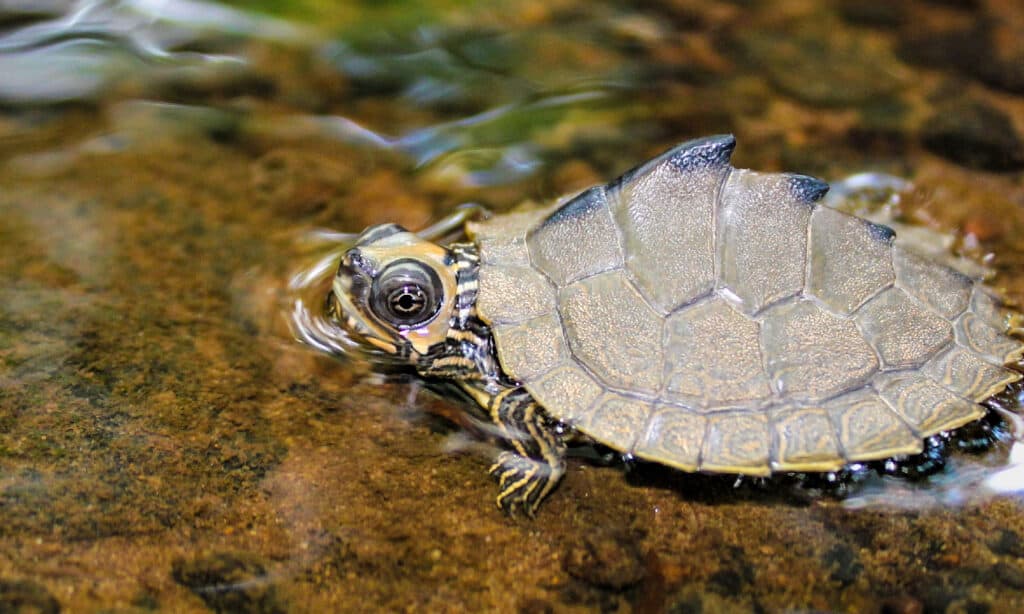
On average, the typical Alabama map turtle ranges from 4 to 11 inches long, with females being much longer and larger than males.
©iStock.com/Tucker Heptinstall
As you might imagine, the Alabama map turtle is one of Alabama’s more common turtle species. Notably, it has a large head and strong jaws for its size, which allow it to easily crack open the tough shells of its favorite food: all kinds of mollusks.
On average, the typical Alabama map turtle ranges from 4 to 11 inches long, with females being much longer and larger than males. Its carapace, or the top portion of its shell, varies in color from dark olive green to dark brown, with a single black stripe down the center. The center of the carapace has a raised ridge (better known as a keel).
The turtle’s plastron (the bottom portion of its shell) is usually pale to dark yellow in color. The turtle’s skin is usually brownish-green with thin yellow striping and a large yellowish marking on the back of the head.
This species is also unique for its very limited geographic range. It mainly lives in the Mobile Bay drainage basin area in coastal plains streams with high mollusk populations. It can also be found in parts of northern Georgia, eastern Mississippi, and the northwest edge of Florida’s panhandle region.
2. Eastern Mud Turtle (Kinosternon subrubrum subrubrum)
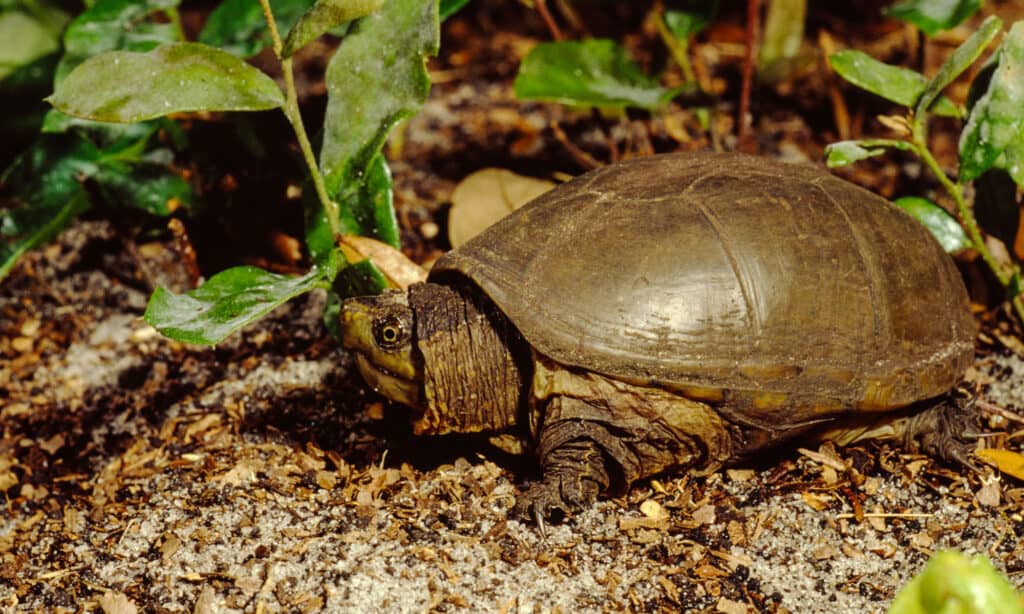
The eastern mud turtle has a rounded, somewhat flat carapace that ranges in color from light yellowish brown to almost black.
©Liz Weber/Shutterstock.com
The eastern mud turtle is actually one of two subspecies of the mud turtle, Kinosternon subrubrum. The other known subspecies is the Mississippi mud turtle.
On average, the eastern mud turtle is just 3 to 4 inches long. It has a rounded, somewhat flat carapace that ranges in color from light yellowish brown to almost black. Its skin is mostly greyish-brown, but its head and neck are often a more mottled brown and yellow. Its webbed feet are fairly large for its size.
This species’ geographic range covers most of the southeast United States from eastern Texas through Florida and as far north as New Jersey. It lives throughout Alabama in various freshwater habitats like ponds, rivers, and streams with clean water and lots of vegetation. However, it can also tolerate brackish water.
3. Three-Toed Box Turtle (Terrapene triunguis)
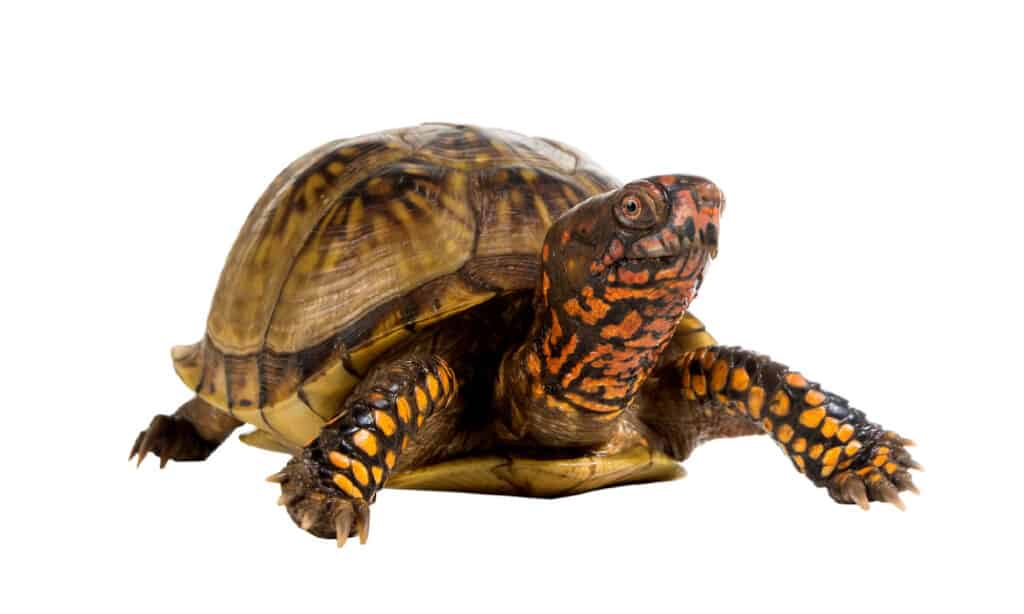
True to its name, the three-toed box turtle often has three toes on its back feet rather than the usual four.
©iStock.com/irin717
The three-toed box turtle gets part of its common name from the number of toes on its back feet. However, some individuals have four toes instead!
The other half of this species’ common name refers to the hinges on its plastron. These hinges allow the turtle to tightly “box” itself into its shell to protect itself from predators. Its carapace is tall, dome-shaped, and varies in color, though it is usually light to dark brown with a darker brown rim. The plastron is dark yellow, while its skin is greyish-brown and occasionally has darker blotches.
The three-toed box turtle’s geographic range covers most of the Gulf Coast area from southern Texas through northern Missouri. It lives throughout most of southern Alabama and can thrive in various habitats, but prefers wooded forests near freshwater ponds, lakes, and streams.
4. Razor-Backed Musk Turtle (Sternotherus carinatus)
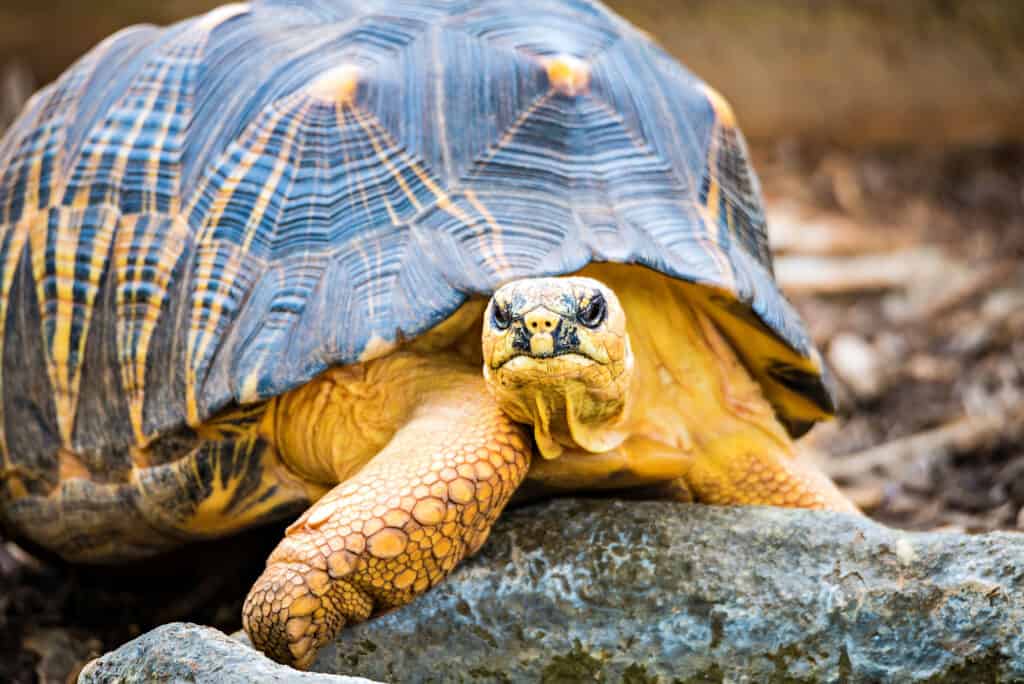
As a highly aquatic species, the razor-backed musk turtle rarely leaves the water.
©iStock.com/alex grichenko
The razor-backed musk turtle gets its rather edgy name from the raised, serrated ridge (or keel) down the center of its carapace.
Generally, razor-backed musk turtles are 5 to 6 inches long on average, though males have much longer tails than females. This species’ carapace is brown with black markings around the edges of each scute. Its skin is usually greyish-brown with tiny, mottled black spots. Interestingly, this species has a reduced plastron with a hinge at the back, a long neck, and somewhat short legs for its size.
This turtle’s range is fairly limited to the southern United States in most of Louisiana, Mississippi, and Arkansas. It can also be found in parts of eastern Texas and Oklahoma. In Alabama, it can only be found along the state’s southern coast. Its preferred habitats are shallow, slow-moving creeks and streams with lots of vegetation. As a highly aquatic species, the razor-backed musk turtle rarely leaves the water.
5. Alabama Red-Bellied Cooter Turtle (Pseudemys alabamensis)
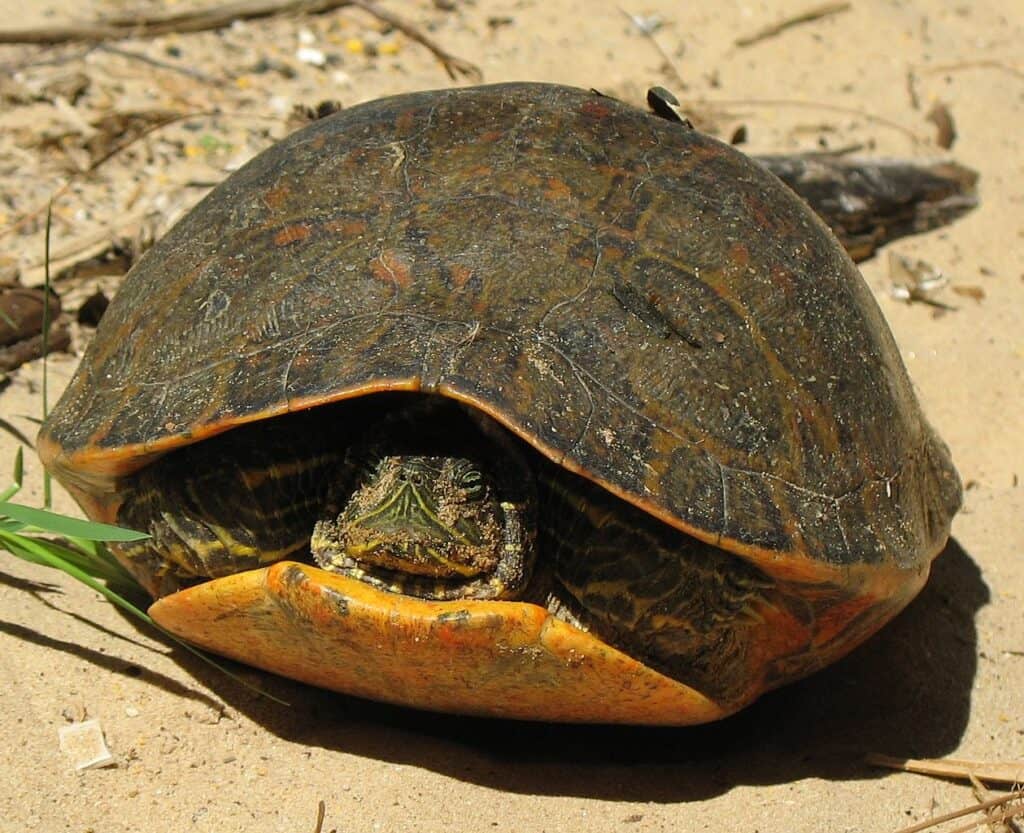
The Alabama red-bellied cooter can thrive in both freshwater and brackish water habitats.
©Alabama_red-bellied_turtle_US_FWS.jpg: Josh Roswell/U.S. Fish and Wildlife Service. TCO / public domain – License
Up next is another turtle species named for the Yellowhammer state: the Alabama red-bellied cooter. It also happens to be Alabama’s official state reptile!
Fairly large, this turtle is around 12 to 14 inches long on average, with females being slightly longer than males. True to its name, it has a bright reddish-orange plastron. Meanwhile, the turtle’s carapace is greenish-brown with a reddish highlight along the edges. It also has a raised keel down the center. The turtle’s skin is typically dark green with bright yellow striping throughout. The bold stripes are especially prominent around its head and neck.
Notably, this species has a very limited geographic range. It is native to a small part of southern Alabama and Mississippi. It can thrive in both freshwater and brackish water habitats, though it prefers freshwater ponds, streams, and swamps with lots of aquatic vegetation. During the day, it spends much of its time basking on nearby logs and rocks.
6. Flattened Musk Turtle (Sternotherus depressus)
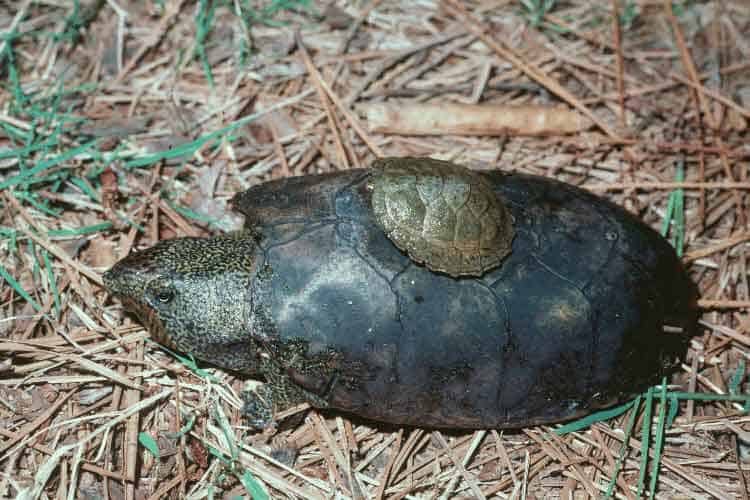
The flattened musk turtle often resides in clean, freshwater creeks and streams with rocky or sandy bottoms.
©Eugene van der Pijll / From: http://cars.er.usgs.gov/Education/sldshw/herpetology/slides.html (slide 24) {{PD-USGov-USGS}} Category:Testudines / public domain – License
Sadly, this unique species is critically endangered due to habitat loss, mainly from erosion caused by strip mining. As a result, it also currently has a very limited range and can only be found in northern and central Alabama.
True to its name, this turtle has a very flat carapace that looks almost like it’s been stepped on. It’s also very small at just 3 to 4 inches long on average. Its carapace is usually solid dark brown, while its skin is mottled dark greenish-brown and yellow. Another prominent trait is its very short, pointed snout.
In terms of its preferred habitat, the flattened musk turtle most often resides in clean, freshwater creeks and streams with rocky or sandy bottoms. It is most commonly found in and around Alabama’s Black Warrior River.
7. Gopher Tortoise (Gopherus polyphemus)
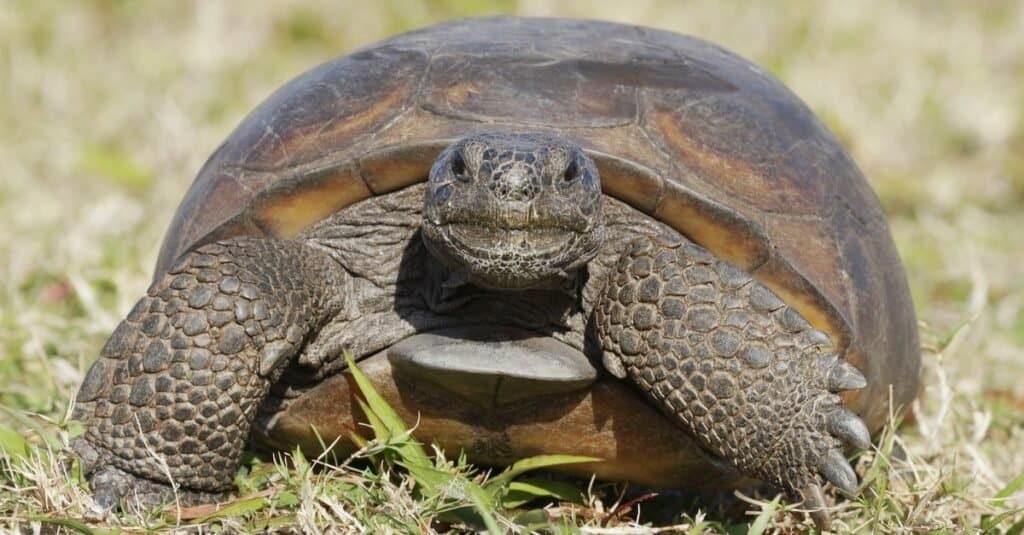
The gopher tortoise has thick, rugged limbs with large, protective scales on its front legs for digging.
©Brian Lasenby/Shutterstock.com
As the only tortoise species native to the southeast United States, the gopher tortoise is very unique. It’s also incredibly useful to the ecosystems it inhabits, as it digs massive burrows that provide shelter to hundreds of other animal species!
The gopher tortoise can be easily differentiated from more aquatic turtle species by its thick, rugged limbs with large, protective scales on its front legs for digging. It averages 7 to 15 inches long and has a very tall, dome-shaped carapace. Both its skin and carapace are greyish brown, while its plastron is yellow. Notably, babies and juveniles are more yellowish overall but darken significantly in color with age.
This species’ geographic range covers much of the US’ southeast corner. It mainly lives in northern Florida, southern Alabama, Georgia, and Mississippi. As a terrestrial species, it thrives in habitats with well-drained, sandy soils that it can dig into easily.
8. Loggerhead Sea Turtle (Caretta caretta)
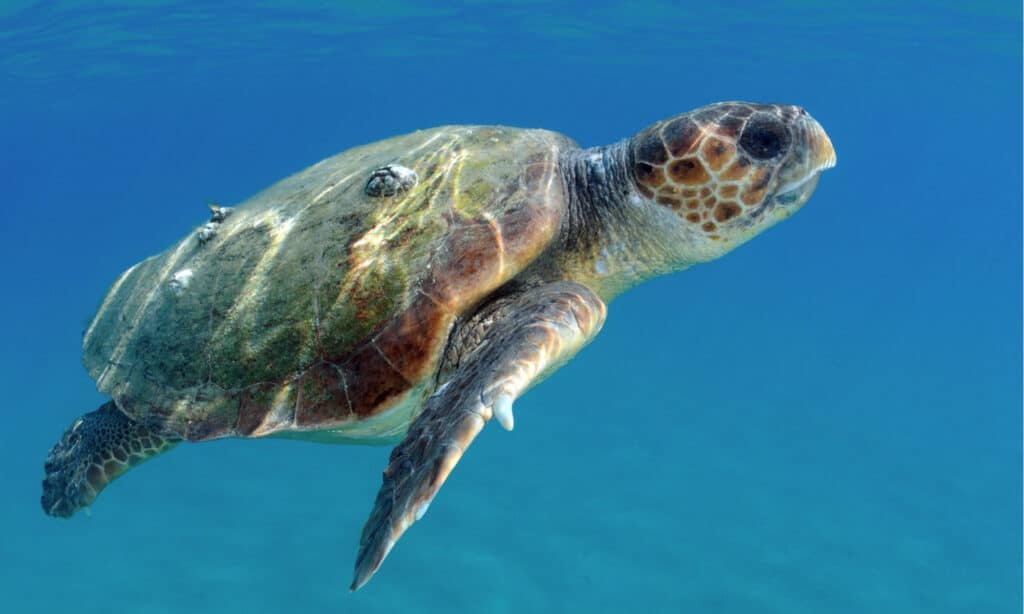
The loggerhead has a reddish-brown carapace and pale, cream-toned skin with lots of reddish-brown splotches.
©Matteo photos/Shutterstock.com
As the world’s largest hard-shelled turtle (and one of the largest turtle species in general!), the loggerhead is easily the largest species on this list.
Named for its large, wide head, the loggerhead has a reddish-brown carapace and pale, cream-toned skin with lots of reddish-brown splotches. Its plastron and the underside of its skin are off-white to pale yellow. Massive in size, it averages 30 to 35 inches long and usually weighs anywhere from 200 to 450 pounds, though very large individuals occasionally weigh much more.
The loggerhead is Alabama’s most common sea turtle species. Every summer, from May through August, it nests along the state’s southern coast in the Gulf Shores area and Fort Morgan and Dauphin Island.
9. Gulf Coast Spiny Softshell (Apalone spinifera aspera)
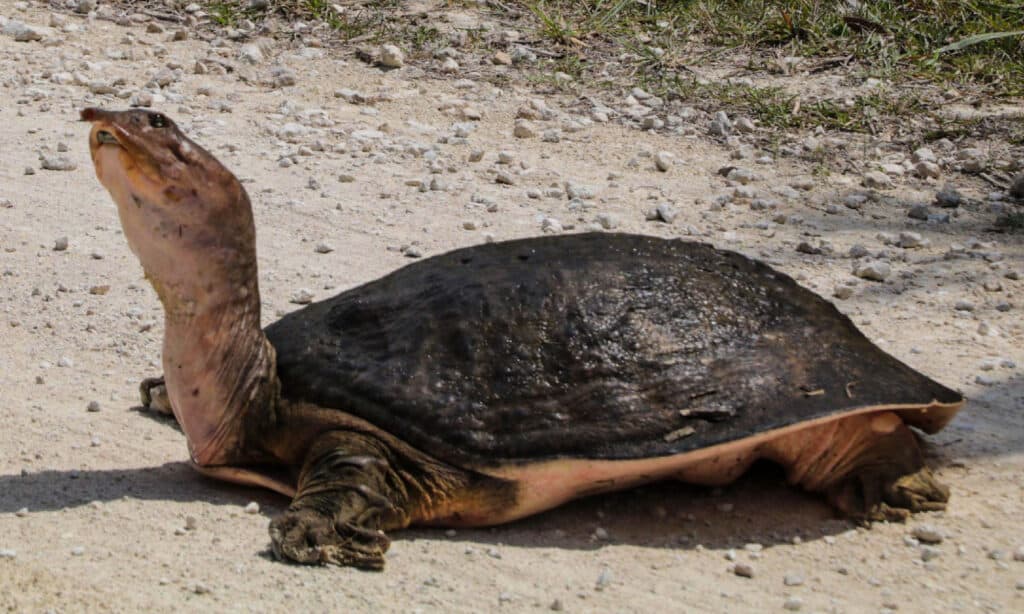
Like other softshells, the Gulf Coast spiny softshell is quite large in size at 10 to 18 inches long on average.
©Mark W. Holdren/Shutterstock.com
This subspecies of the spiny softshell can be differentiated from the five other subspecies by the black lines running along the edge of its carapace. As its name suggests, it lives throughout the Gulf Coast area of the United States.
Like other softshell turtle species, the Gulf Coast spiny softshell has a flat, smooth shell with no scutes. The turtle’s carapace is olive green to greyish-brown in color with tiny back spots. Its skin is light tan to light brown with yellow and brown markings along the head and neck. It has a long, narrow, upward-pointing snout. Also, like other softshells, it’s quite large in size at 10 to 18 inches long on average.
This species’ geographic range covers most of the Gulf of Mexico’s surrounding area from North Carolina to Mississippi. It can also be found in southern Alabama. Hardy and adaptable, it is highly aquatic and can live in various freshwater habitats but prefers open ponds, lakes, and marshes with sandy or muddy bottoms.
10. Southern Painted Turtle (Chrysemys dorsalis)

The southern painted turtle is easy to identify thanks to the orange to reddish stripe running down the center of its greenish-brown carapace.
©Mike Wilhelm/Shutterstock.com
The southern painted turtle is the smallest of all painted turtle species and subspecies! It averages just 4 to 6 inches in length.
Though it was once considered a subspecies of the painted turtle, the southern painted turtle is now–rather confusingly–designated as its own species. It is fairly easy to identify thanks to the orange to reddish stripe running down the center of its greenish-brown carapace. Its plastron is usually yellow or tan, while its skin is dark green with bold yellow stripes.
This little turtle’s geographic range covers most of Arkansas, Missouri, Louisiana, and parts of west Tennessee and Alabama. It favors slow-moving freshwater habitats like lakes, streams, ponds, and marshes with some aquatic vegetation. However, it can also tolerate brackish water.
Up Next:
The photo featured at the top of this post is © iStock.com/alex grichenko
Thank you for reading! Have some feedback for us? Contact the AZ Animals editorial team.






